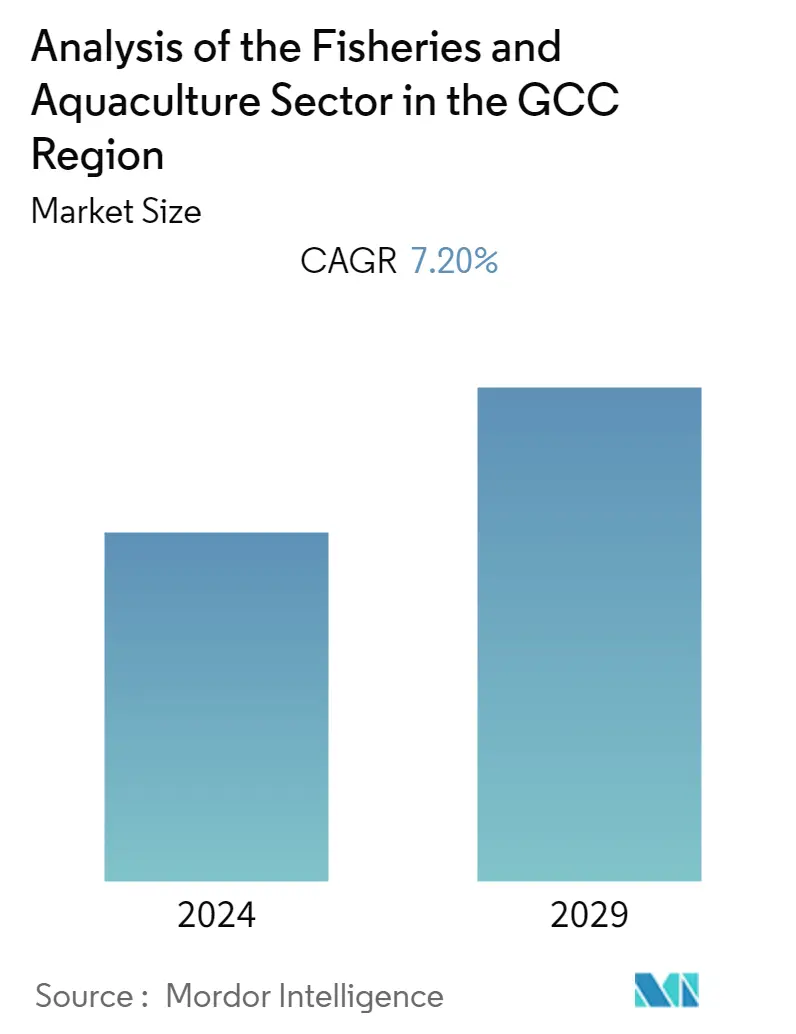Market Size of Analysis of the Fisheries and Aquaculture Sector in the GCC Region

| Study Period | 2019 - 2029 |
| Base Year For Estimation | 2023 |
| Forecast Data Period | 2024 - 2029 |
| Historical Data Period | 2019 - 2022 |
| CAGR | 7.20 % |
Major Players*Disclaimer: Major Players sorted in no particular order |
GCC Fisheries and Aquaculture Market Analysis
The GCC fisheries and aquaculture market is estimated to register a CAGR of 7.2% during the forecast period.
- The drivers identified in the market are a rapid rise in the population, an increase in affluent households, a focus on diversification, and changing diet preferences. The restraints identified in the market are unsustainable capture fishing patterns, a low level of informal fisheries consolidation, and a low level of knowledge and technology dissemination.
- According to the Ministry of Environment, Water & Agriculture (M EWA), the country's local seafood market is thriving, and Saudi Arabia's seafood consumption is expected to grow by 7.4% per annum until 2030.
- Population growth and increased consumption per capita will generate additional demand in the coming years. With a declining growth in capture fisheries and stricter safety regulations imposed on imports, aquaculture is set to be the main source of seafood supply for the Kingdom. This is expected to grow the market during the forecasting period.
- The MEWA has established strict regulations, such as the mandatory Global Aquaculture Alliance/Best Aquaculture Practices (GAA/BAP) certification. The country plans to be the first in the world to have a national-level BAP certification. This can help ensure environmentally safe and sustainable products. Furthermore, this will help in the safety and security of the country along with environmental issues and tends to grow the market in the coming years.
GCC Fisheries and Aquaculture Industry Segmentation
Fisheries and aquaculture can be defined as raising and harvesting aquatic organisms, including wild marine and freshwater fish, for food or industrial purposes.
The fisheries and aquaculture sector in the GCC region is segmented by type (pelagic fish, demersal fish, freshwater fish, and scallop) and geography (Saudi Arabia, United Arab Emirates, Oman, Qatar, Bahrain, and Kuwait). The market includes production analysis (volume), consumption analysis (value and volume), export analysis (value and volume), import analysis (value and volume), and price trend analysis across the GCC.
The report offers market estimation and forecasts in value (USD million) for the above-mentioned segments.
| Type | ||||||
| ||||||
| ||||||
| ||||||
| Scallop | ||||||
| Lobster | ||||||
| Shrimp | ||||||
| Caviar | ||||||
| Other Types |
| Geography | |
| Saudi Arabia | |
| United Arab Emirates | |
| Oman | |
| Qatar | |
| Bahrain | |
| Kuwait |
Analysis of the Fisheries and Aquaculture Sector in the GCC Region Size Summary
The GCC aquaculture market is poised for significant growth, driven by factors such as population increase, rising affluent households, and shifting dietary preferences. The region's focus on diversifying its economy and enhancing food security has led to a burgeoning aquaculture sector, particularly in Saudi Arabia and the UAE. The decline in capture fisheries and stringent import regulations have positioned aquaculture as a crucial source of seafood supply. The Saudi Ministry of Environment, Water, and Agriculture (MEWA) is spearheading initiatives to ensure sustainable practices, including the implementation of the Global Aquaculture Alliance/Best Aquaculture Practices certification. This regulatory framework aims to bolster the safety and sustainability of seafood products, aligning with the Kingdom's broader economic diversification goals.
Government policies across the Gulf region are fostering a conducive environment for aquaculture development, with substantial investments and infrastructure projects underway. Oman, for instance, is making significant strides with large-scale investments to enhance its aquaculture capabilities. The UAE is also prioritizing aquaculture as a means to bolster food security, with a growing demand for seafood driven by urbanization and economic growth. The region's aquaculture industry is witnessing increased local demand and public support for new developments, such as Saudi Arabia's ambitious Neom project, which aims to leverage advanced fish farming technologies. These efforts are expected to position the GCC as a leader in sustainable marine aquaculture, meeting both domestic and export demands.
Analysis of the Fisheries and Aquaculture Sector in the GCC Region Market Size - Table of Contents
-
1. MARKET DYNAMICS
-
1.1 Market Overview
-
1.2 Market Drivers
-
1.3 Market Restraints
-
1.4 Value Chain Analysis
-
-
2. MARKET SEGMENTATION
-
2.1 Type
-
2.1.1 Pelagic Fish
-
2.1.1.1 Sardine
-
2.1.1.2 Mackerel
-
2.1.1.3 Tuna
-
2.1.1.4 Barracuda
-
-
2.1.2 Demersal Fish
-
2.1.2.1 Grouper
-
2.1.2.2 Trevally
-
2.1.2.3 Emperor
-
2.1.2.4 Pomfret
-
-
2.1.3 Freshwater Fish
-
2.1.3.1 Tilapia
-
-
2.1.4 Scallop
-
2.1.5 Lobster
-
2.1.6 Shrimp
-
2.1.7 Caviar
-
2.1.8 Other Types
-
-
2.2 Geography
-
2.2.1 Saudi Arabia
-
2.2.2 United Arab Emirates
-
2.2.3 Oman
-
2.2.4 Qatar
-
2.2.5 Bahrain
-
2.2.6 Kuwait
-
-
Analysis of the Fisheries and Aquaculture Sector in the GCC Region Market Size FAQs
What is the current GCC Region Fisheries and Aquaculture Market size?
The GCC Region Fisheries and Aquaculture Market is projected to register a CAGR of 7.20% during the forecast period (2024-2029)
What years does this GCC Region Fisheries and Aquaculture Market cover?
The report covers the GCC Region Fisheries and Aquaculture Market historical market size for years: 2019, 2020, 2021, 2022 and 2023. The report also forecasts the GCC Region Fisheries and Aquaculture Market size for years: 2024, 2025, 2026, 2027, 2028 and 2029.

